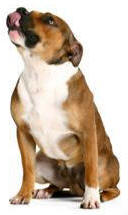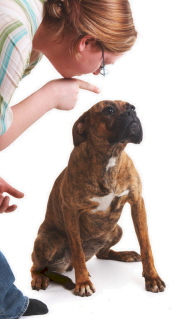 Using
hitting to punish a pet for biting is a
risky choice for many reasons.
Using
hitting to punish a pet for biting is a
risky choice for many reasons.
Although most people think they are
"punishing"
the pet for biting, by definition,
punishment (delivered correctly) decreases
a behavior.
Correct
use of punishment (correct in
this instance means there is a good
chance of success) requires three
important elements.
First, the punishing
stimulus (what the person does such as
hitting the pet) must be delivered within a
second of the behavior the person wants
to
decrease.
Second, the punishment must be
applied every time the behavior occurs
(which is difficult when the person
is absent or not close enough for
the one second rule above).
Third, it must be strong enough to be
effective which is hard to do without causing fear or
harm to the pet .1
Since
most people can't meet all of these
three requirements, the most likely
result of hitting as a punishment is a
pet who learns to avoid the person who
does the punishing and a pet who is more likely to fear
(and bite) a person's hands.
 Thus pet parents (although unaware)
who hit pets are more likely to be increasing the chance the pet will
bite again not decreasing the likelihood
of a future bite.
Thus pet parents (although unaware)
who hit pets are more likely to be increasing the chance the pet will
bite again not decreasing the likelihood
of a future bite.
Punishing pets is associated with four
detrimental side effects2:
Another potential pitfall of punishment
is that the pet parent is failing to
teach the pet what to do, which
is easily done by using positive
reinforcement—a stimulus that
increases the chance a behavior will
recur.
Teaching the pet what to do
instead of punishing it for what you
do not want it to do is usually the safer
and more effective solution to biting
and other unwanted pet behaviors.
Punishing
pets using physical force can damage the
relationship between people and pets and
often results in a pet who is fearful
and anxious around family members as well as
others.
Remember this rule of thumb:
"If the behavior didn't matter to the
pet, the pet wouldn't keep doing
it."3 Pets tend to
repeat behaviors that they perceive to
be in their best interest.
Approach all pet problem behaviors by
trying to understand how the behavior is
reinforcing to the pet.
If a pet's underlying motivation can be
found, the pet parent can look for a
more desirable behavior the pet can
learn to do in place of the unwanted
behavior.
For example, if this pet bites
only when the pet parent walks by a
certain place in the home, such as a
window or door, or when the pet parent
raises his voice and talks in an excited
manner with someone, then the pet
may be biting out of fear.
When the pet
parent then throws the pet to the floor,
the pet has succeeded in escaping the
scary stimulus. So the pet has
learned that biting is an effective
means of escape, and its behavior has
actually been reinforced instead of
punished.
Determine why an pet does
something and how that behavior may be
being reinforced, and then identify a
new appropriate behavior the pet parent can
teach and reinforce.
Continuing with this example, where fear
is the root of the problem, the pet
parent should consider teaching the pet
words that mean "back off" or "sit" or
some other behavior that can be rewarded
instead of punishing the biting.
The new,
desired
behaviors can be encouraged to repeat by
giving tiny
tasty treats.
Eventually, the
biting behavior will be extinguished
(stop occurring) if that behavior no
longer serves any purpose from the pet's
experience and perception.
It is also critical that the pet
parent observe the pet to recognize
any signs of fear and the
stimuli that causes it. A program of
desensitization and counter-conditioning
can be used to decrease the pet
's fear of these particular stimuli.
Desensitization means the pet is
exposed to the stimulus that triggers
the fear from enough distance to
decrease the fear response even though
the pet is aware of the feared stimulus.
The idea is to get the pet more
comfortable around the stimulus.
To speed up
the comfort, give the pet a tasty treat
for looking at the stimulus that creates
the fearful response
(counter-conditioning). Your goal is to
shape a new response to the stimulus.
Instead of the pet focusing on fear, the
pet begins to focus on "where's my
treat." Over time, the pet can be
a little closer to the stimulus without
a fearful response. Each time the pet
gets completely comfortable, another
baby step forward is taken and the
counter-conditioning (treat for
non-fearful behavior) begins again.
Once
a pet learns that one behavior is
regularly followed by a positive
reinforcement, it will usually choose
that behavior more than the behavior
that is not being reinforced.
Reinforcing appropriate behaviors should
always be tried first. Punishment should
never be the first choice and can only
be recommended after all other safer,
more humane methods have been tried. If
punishment is to be used, it must be
used carefully, according to the rules
described above and abandoned when it
does not appear to be working, as in the
case described here.
Understanding how pets learn
and how to safely decrease an unwanted
behavior while increasing a more
desirable substitute can be complex. If you feel
unprepared to manage a particular
behavior problem, work with a Veterinary
Behavior Consultant who may refer you to
a veterinary behaviorist.
1.
Schwartz B, Wasserman EA, Robbins SJ.
Operant conditioning: Basic phenomena.
In: Psychology of learning and
behavior. 5th ed. New York: W.W.
Norton & Company, 2001;132-164.
2. Azrin NH, Holz WC. Punishment. In:
Honig WK, ed. Operant behavior: Areas
of research and application. New
York: Appleton-Century-Crofts,1966.
3. Friedman SG, Haug L. From parrots to
pigs to pythons: Universal principles
and procedures of learning. In: Tynes
VV, ed. The Behavior of Exotic Pets.
Blackwell Publishing, in press.